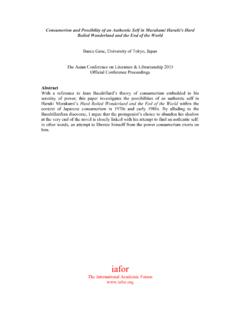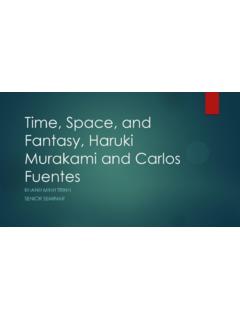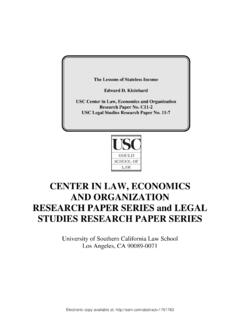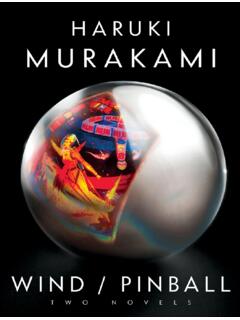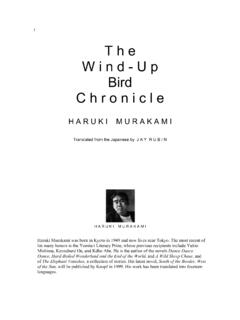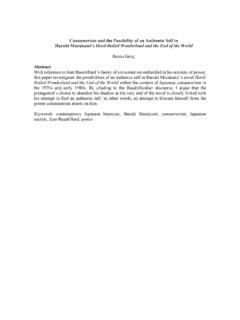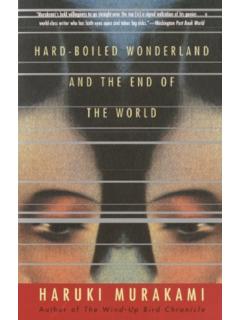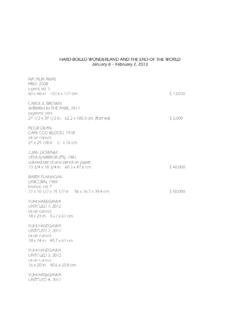Transcription of Hard-boiled Wonderland and the End of the World
1 Hard-boiled Beauty and the End of the World Candace Wiersema Supervisor: Michael Jemtrud April 01, 2008 (Fifth Draft) Haruki Murakami s fiction, The hardboiled Wonderland and the End of the World is a point of departure for revisiting historical and contemporary perspectives of beauty, and the potential of vision to elicit memory and imagination in architecture. The context includes the above conditions and is situated beneath the Jacques Cartier Bridge, bisecting the historical and abandoned Craig Pumping Station, which will be reinterpreted as a Station for Media, Architecture and Technology. A fiction is a reflection of its culture and its contemplations, as well as a medium for exploring the potential of social narrations that linger in the depths of memories and imagination. The conscious World , however, has become a cycle of spectacular objects, lacking aura and is the result of an excess of stimuli, rather than a lack it is the very shocking nature of our contemporary society that breeds monotony (Benjamin [1997] 111).
2 The image within architecture has slowly been declining from aspiring to reside in the experience of the body, mind, and soul, to a flat three-dimensional object . The inherent and often untapped tool of the imagination, together with an understanding of the contemporary field of vision and the developments of new media, can become a means for uncovering creativity, expression and beauty. 2 Thesis Premise: an unconscious culture Benjamin believed that as opposed to conscious recreation of aura, one must first become accustomed to the monotony, and that the dialectical image may trigger a moment of involuntary memory, beginning to dispel the nightmare (Cassegard 82). In the novel, Haruki Murakami narrates through a World of mundane and complacent consciousness ( Hard-boiled Wonderland ), and a World of the timeless black box of the unconscious (the End of the World ). The duality presented draws the character and the reader through an allegory of the divided conscious mind -- a system of collected experiences from the past, of which, memory is the choice weapon for survival (Murakami 10).
3 Society then, has become used-to the monotony, and thus, beauty can begin to be re-discovered within our current field of vision, which is the city. The context of this discovery is the situated beneath the Jacques Cartier Bridge in Montreal, including the historical structure of the Craig Pumping Station. Through an understanding of beauty in the 21st century , adapted from Inaki Abalos, the possibility of the duality of the real and the imagination is used to trigger a sense of place. Photographic images of the site are constructed into physical hallways of vision , that create artifices of representation, exploring the possibility to return memory and the conscious mind to Architecture. The proposed Station for Media, Architecture and becomes a platform for critical thought, inhabitation, and integration of art and science: thus imagination. 3 Primary Area of Study: the beauty of the imagination Today, in contemporary architecture, we are in a blender of aesthetic models.
4 It is critical to the survival of beauty that we are able to define that which is essential and that which is applied. Inaki Abalos defines the seven ideas of Beauty in the Twenty-first Century as formless , environmental , banal , pragmatic , neo-materic , picturesque , and procedural . These conditions, as have been adapted, construct the focus explored and modeled through site photography and physically constructed hallways of vision . The goal is to develop a visual relationship in which subject, object and observer all exist, as does the conscious and unconscious mind. Murakami expresses that most have no real grasp of their own cognitive systems (Murakami 10), however, through his methodology of dual narratives lies the possiblility to transpose oneself into the other. Not only do the two worlds exist simultaneously, in Murakami s fiction, but also he often pulls pieces and characters from one into the other.
5 In Simulacra and Science Fiction, Baudrillard states, It is no longer possible to manufacture the imaginary from the data of reality. The process will be rather to put in place decentred situations; to reinvent the real as fiction (Baudrillard 81). The argument here is that the simulacrum is most effective when both the conscious and unconscious mind is present. Beginning with the context of the historical narrative of the Craig Pumping Station and the continual transferal sequence of the Jacques Cartier Bridge Site, beauty is made manifest through infusion of the self and memory into one s own hallway of vision . Spaces of subject, object and observer. 4 Program: creating creative consciousness Architecture is about imagination. Suddenly we have witnessed the unimaginable, and imagination has been taken from us. Can we architects ever imagine again? Peter Eisenman The program consists of a therapeutic habitat for exploring the status of architecture within current society.
6 In response to concerns of the abstraction of vision, the abomination of technology, the exclusion of the event and the conclusion of culture, architecture seeks to return to its fundamentals of vision and beauty. The structure of the Station for Media, Architecture and Technology includes a public library of contemporary thought, a digital experimentation facility, active body studios, photographic and design studios, and temporal dwelling for its clients. Consideration will be given in examine what it is for both male, female artists of new media, arts and technology. In 2002 the Champ Libre organization restored the abandoned Craig Pumping Station for the fifth Manifestation Internationale Vid o et Art lectronique. Champ Libre coordinates insitu installations that temporally transform often derelict spaces into public events. Parallel to the mission of Champ Libre, the Station for Media, Architecture and Technology welcomes all disciplines exploring and researching arts and new technology (Champ Libre [2004] 02).
7 The architecture looks to be informed and developed with a strong sense of program, drawing information from contemporary visual culture, with particular interest in Montreal s visual media and arts. 5 Site: past & future, memory & imagination, quiet & passage The elevator continued its impossibly slow ascent. Or, at least I imagined it was could have been going down for all I knew, or maybe it wasn t moving at Maybe I d gone up twelve stories, then down three. Maybe I d circled the globe (Murakami [1991] 1). The site is located beneath the Jacques-Cartier Bridge, north of the river. The site benefits from the nature of passage, which as shown in the Hard-boiled Wonderland and in personal experience, imagination and clear thought is evoked in the everyday in spaces of commute and points of pause along the route (Fig. 1). This relatively mundane situation, within the urban context acts a point of departure into worlds of imagination and memory, similar to those found within Murakami s work.
8 Within this context the characters within the architecture embark on a journey of the marvelous and fantastic in everyday life. The context is not merely the physical site, but also its historical narrative, the contemporary perspective of beauty and the current state of the conscious mind. The history and the present proximity to water becomes part of the architectural account of the site, triggering nostalgia and contemplation. Visual activation of the inhabitants will trigger these movements intrinsic within the programmatic sequence of the Station for Media, Architecture, and Technology. In the End of the World the narrator recognizes, "An indelible intimacy of memories long departed from [one s] eyes" (Murakami 14). Consider then, that the city is above all, a field of vision, a primarily visual experience: a structure of visibility (Seats 89). 6 Mode of Production: creating doubles Next thing I did was t read your black box into the computer pre-programmed with those patterns, and out came an amazin graphic renderin of what went on in your core the images were.
9 Fragmentary and didn t mean much in themselves. They needed editin ..Rearrangin everything into a story (Murakami [1991] 262). Contemporary aesthetics are simultaneously appearing as reproductions of the Modern era, as continuations of postmodern and contemporary thought, and possibly the most disputed, those arising from a recent culture of technology and mechanical social masses. In defining beauty and what is valuable consciousness, arises in order to face the present, in which similar attempts awaken a visceral rejection by the architects themselves (Abalos 5). The common visual relationship between the conscious subject and the object of its existence is vis- -vis a mirror or direct reflection. This relationship is rather isolated than dependant, thus instead, the goal is to develop a visual relationship in which subject, object and observer all exist. In this situation, the polarity of vision is refracted into a three dimensional space.
10 In Michael Seats, Theory of the Simulacrum , he reflects on Baudrillard s simulacra as the image , the artifice , the form and the representation . In efforts to understand the 7 ideas of beauty as outlined by Abalos in relation to the vision of the conscious and the unconscious mind, the above are physically constructed. Site photographs act as the image and the artifice is constructed as a digital reading of the site, which are together constructed into one hallway of vision . The form is then represented. 7 Conclusion: remembering to imagine The consciousness and the unconscious mind is something that every human being possesses. However, unlike an tongue or a tendon it is shaped and conditioned in a way that is intangible. Our unconscious affects how we move through life everyday it is our black-box of memories. What is most complex and interesting is that while an image or a physical point of view can be seen as a fixed object, what one sees is actually translated through one s unconscious first.
